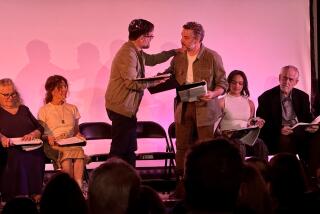Subject Is Hazardous-Waste Dumping : Play Elicits Dialogue After the Curtain Falls
Many theatergoers would envy the opportunity that Louis Biderman had last week at the Back Alley Theatre in Van Nuys.
After the eveningâs play ended and the lights came on, the management asked Biderman to comment on the play and its main topic--hazardous waste dumping.
âThe issue is a very serious one, very important, but the play was totally unrealistic,â said Biderman, a Van Nuys resident who was in the audience at a preview last Wednesday night.
âPeople are like that,â countered another playgoer, Debbie Olsen of Granada Hills, referring to the characters on stage. âI know people like that.â
The remarks typified the openness and contrasting perceptions of audience members that enlivened the Back Alleyâs most emphatic effort yet to link a play to the social or political realities it reflects. The play is called âRingers,â and the Back Alley is holding audience forums after every Wednesday performance to explore the environmental issues the play raises. The comments were made at the first of the forums.
In the past, the theater has never held more than one audience forum per production.
Contaminated Bricks
âRingers,â set in Denver, focuses on a masonâs dilemma about what he should do with a large number of radioactive bricks he has bought. Denver playwright Frank X. Hogan based his play on the 1979 discovery in his home city of 31 radioactive dump sites. The sites contained radioactive ores and their byproducts that were dumped by the flourishing ore-processing industry the city had in the 1920s. Some of the ore was found in a brickyard.
The play has only one reference to the actual dump-site discoveries, but Hogan says that, in Denver, where the play was first produced a year ago, audience members were aware of its link to the headline-making incidents that inspired it.
Laura Zucker and Allan Miller, the Back Alleyâs artistic directors, are trying to create a similar connection for their audience, drawn mostly from the San Fernando Valley. On the programâs cover is a collage of stories and headlines on news events in the Valley, such as â13 Area Firms Hit With Air-Pollution Penalties,â â2 Charged With Illegal Storage of Explosives in Northridge Shopâ and âScores Hurt by Leaking Chemicals.â
The Back Alley has invited officials from local environmental agencies and activists from the Sierra Club and other groups to lead audience discussions on hazardous-waste dumping at Wednesday performances through Dec. 18. The play, which has been in previews since Halloween, had its formal opening Saturday night.
The invited experts last Wednesday were Fritzi Bernstein, solid-waste chairman of the Sierra Clubâs Southern California Regional Conservation Committee, and Florence Pearson, a state waste-management specialist. The two women sat before the audience with Diana Daves, an actress who handles public relations for the Back Alley, between them to field the questions.
Only about 10 of the 80 people who attended the play stayed for the discussion. Asked if the forum was successful, Zucker said: âYes and no. I wish more people had stayed, but I felt that those who stayed, there were some valuable things expressed. The purpose for the forum is to get people thinking.
âTo tell you the truth, the ground-water problem in the Valley terrifies me,â Zucker said, referring to government reports of polluted wells in the area. âI think other people are concerned but no one knows what to do.â
A number of those who stayed for the discussion also seemed to share Zuckerâs worry about local hazardous-waste problems. âIt seems that every day Iâm reading in the paper about more and more illegal dumping in the Valley,â one woman said. âIs the problem getting worse or are we just hearing more about it?â
âProblems Getting Worseâ
Before anyone could answer, another woman said, âSanta Monica Bay; boy, some of the problems are getting worse.â
Answered Pearson: âI think itâs both. I think there is more reporting, but I also think the problem is a big one.â
âWhy arenât they stopping the manufacturing of toxic wastes?â asked Joanne Fleischer of Northridge.
Pearson said the government is using the threat of monetary penalties to persuade industries to reduce the quantity of hazardous waste they produce. But it is a slow process, she added.
In a telephone interview from Denver, Hogan, 36, who writes feature stories and a weekly column for an alternative paper called Westword, said he wrote the play to explore the personal side of the environmental issue.
âI wanted to show that itâs not just something in a headline,â Hogan said. âHere in Denver we have a very bad air pollution problem, and the city has instituted a clean-air program, which is a voluntary program designed to get people to not drive one day a week. Itâs not working. Nobody wants to take the responsibility, nobody wants to take their little part.â
In Hoganâs play, the mason, Keith Rankowski, buys the bricks at a discount from his brother-in-law, who has not told him they are radioactive. The mason knows something is wrong but he doesnât ask questions, and instead dreams of making a big profit on his next job. When the truth about the bricks is discovered he is blackballed in the industry.
House of Bricks
To prove to colleagues that he is a superb bricklayer and that he is not dumping the bricks, he uses them to build an elaborate house. However, his wife becomes pregnant and moves out, and Rankowski must decide whether to leave also or live in a radioactive house.
Zucker, whose husband, Miller, directed the play, said she had hoped the audience forum would revolve around environmental topics. Some of the comments did. But the discussion also focused on the mechanics of the play, Hoganâs first professionally produced effort.
âIt seemed to me that the author was trying to do two things and neither of them worked,â said Dr. Elizabeth Beale of Thousand Oaks. âHe was trying to deal with some serious issues and he was trying to write some sort of comedy. I didnât think it was funny.â
Said Fleischer: âI thought it was funny. And if it werenât funny, it would have been depressing.â
âI regard it as a kind of allegory,â the Sierra Clubâs Bernstein said. âHere we have a person who is trying to deal with a moral dilemma and with all the aspects of his personal life, too. I donât think it was a great play, but if you look inside the playwrightâs mind you can see that he had some pretty important ideas to deliver.â
More to Read
The biggest entertainment stories
Get our big stories about Hollywood, film, television, music, arts, culture and more right in your inbox as soon as they publish.
You may occasionally receive promotional content from the Los Angeles Times.










